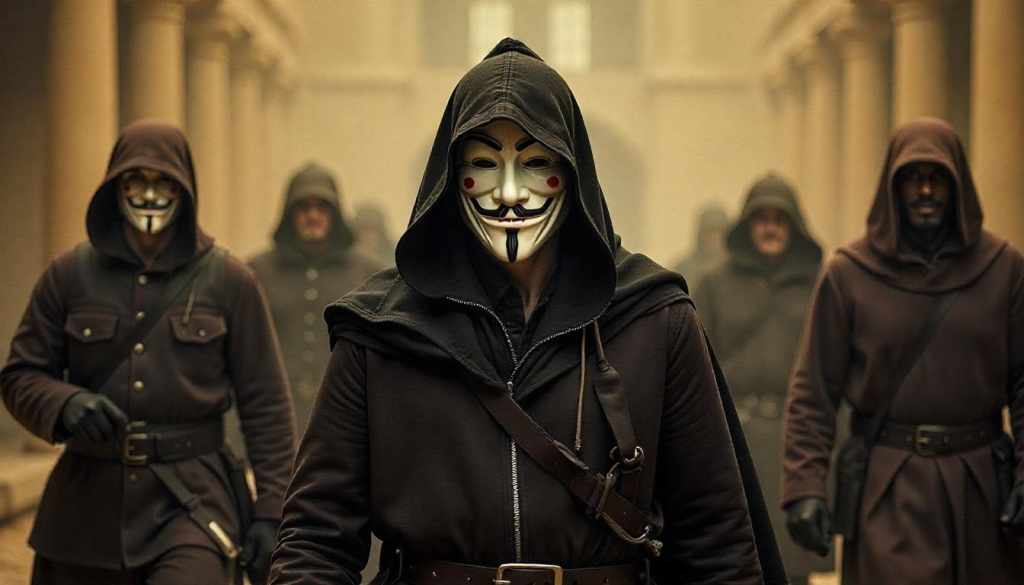Anonymous, the mysterious and loosely organized online group, is often referred to as a “collective” rather than an organization or a club. But what does this really mean? Why is the term “collective” so important when talking about Anonymous? To answer this, we need to explore how Anonymous began, how it operates, and what makes it different from other activist groups.

What Is Anonymous?
Anonymous is not a registered group or formal organization. It has no headquarters, no leader, and no official membership list. It started in the early 2000s on internet message boards like 4chan, where users posted without names — simply as “Anonymous.” Over time, this idea evolved from casual online behavior to coordinated digital activism.
The Collective Identity: What It Means
The word “collective” implies that the group is made up of many individuals working together — but without a clear hierarchy. It’s a group where everyone is equal, and anyone can participate. There are no leaders telling others what to do. Instead, if someone starts a campaign that others agree with, they join in. If not, they don’t. This openness and equality are the heart of why Anonymous is called a collective. It’s less about following orders and more about shared values and actions.
How It All Began
Anonymous first gained attention for online pranks and trolling. But in 2008, the group made headlines with Project Chanology, a protest against the Church of Scientology. Members protested outside Scientology centers wearing Guy Fawkes masks and also launched online attacks. This was a major turning point — shifting Anonymous from internet mischief to serious digital activism. From that moment, the group began to focus more on social justice, human rights, and political causes.
No Leaders, Just Causes
One of the most unique things about Anonymous is that it doesn’t have a leader. Anyone can plan an operation and invite others to take part. If the idea resonates with others in the community, it gains momentum and becomes an Anonymous operation.
Because of this, people across the globe can take part in Anonymous actions without needing permission or formal roles. This lack of leadership structure is a big reason why it is referred to as a collective — not a group you join, but a cause you stand for.
What Do They Believe?
Even though Anonymous has no official rulebook, many of its members share similar values. These include:
-
Freedom of speech and information
-
Digital privacy and anonymity
-
Fighting censorship
-
Exposing corruption
-
Supporting oppressed people and groups
These common beliefs form the moral glue of the collective. If someone acts in the name of Anonymous but goes against these ideals, others in the community may reject their actions — showing that even a decentralized group has a form of internal accountability.
The Power of the Guy Fawkes Mask
The Guy Fawkes mask, made famous by the movie V for Vendetta, is now the global symbol of Anonymous. It hides the identity of the wearer and sends a powerful message: “I am no one, and I am everyone.” Wearing the mask turns one individual into a part of a much larger group — the collective. This symbol adds to the idea that Anonymous isn’t about one person but about many people acting together for a shared purpose.
Examples of Collective Action
Anonymous has been involved in many high-profile campaigns, including:
-
Operation Payback: Defending internet freedom by targeting anti-piracy organizations.
-
Support for WikiLeaks: Protesting against companies that tried to cut off financial services to WikiLeaks.
-
Arab Spring: Helping activists in countries like Tunisia and Egypt access information and avoid censorship.
-
Operation Ferguson: Supporting protests against police violence in the United States.
In each of these cases, there was no single person giving orders. Instead, someone proposed an idea online, others agreed, and the campaign took shape — a perfect example of collective digital action.
Strengths and Weaknesses of a Collective
Strengths:
-
Decentralization: No leader can be arrested or silenced to stop the movement.
-
Flexibility: Anyone can start a new campaign at any time.
-
Anonymity: Members can act without exposing their real identities.
Weaknesses:
-
Lack of control: Anyone can claim to be Anonymous, even for harmful actions.
-
No unified voice: Since everyone operates independently, the group sometimes appears inconsistent.
-
Legal risks: Participants may face criminal charges, especially if they’re involved in illegal hacks.
Even with these challenges, the collective nature of Anonymous allows it to stay alive, grow, and evolve with the times.
Why the “Collective” Model Works
The world is used to top-down leadership — from governments, businesses, and even NGOs. Anonymous breaks this mold. Its horizontal, collective model is built for the internet age, where ideas can spread faster than ever. When one person speaks, they might be ignored. But when thousands act together — even if they’ve never met — the world notices. That’s why Anonymous, though faceless and leaderless, has been able to impact global events. It’s proof that a collective of strangers with a shared mission can be powerful.
Final Thoughts
So, why is Anonymous called a collective? Because it truly is one — a loose, leaderless network of individuals who unite around shared beliefs and act together. It’s not about one person’s power, but about many people’s passion. Anonymous represents a new way of organizing in the digital age — one where anyone, anywhere, can be part of something bigger. Whether it’s fighting censorship, standing up for justice, or defending privacy, the group’s collective identity gives it strength, resilience, and the power to surprise the world again and again.